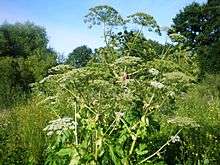Heracleum sosnowskyi
| Heracleum sosnowskyi | |
|---|---|
 | |
| Scientific classification | |
| Kingdom: | Plantae |
| (unranked): | Angiosperms |
| (unranked): | Eudicots |
| (unranked): | Asterids |
| Order: | Apiales |
| Family: | Apiaceae |
| Genus: | Heracleum |
| Species: | H. sosnowskyi |
| Binomial name | |
| Heracleum sosnowskyi Manden., 1944 | |
Sosnowsky's hogweed (Heracleum sosnowskyi) is a flowering plant in the family Apiaceae, originally native to Caucasus. Now it is a common weed in the Baltic States, Belarus, Russia, Ukraine, and Poland.
The species is named in honor of the Russian botanist Dmitrii Ivanovich Sosnowsky (1885-1952), who found the species in Georgia in 1936.[1]
H. sosnowskyi is 3–5 m in height,[2] with a straight, firm stem that can reach a diameter of 12 cm.[2] The leaves are 50–60 cm long. The root is very firm, up to 30 cm diameter. The inflorescence is a big umbel found at the end of every stem. It blooms during July through September and produces thousands of seeds. They are easily distributed by the wind, but especially by the water.
All parts of H. sosnowskyi contain the intense toxic allergen furanocoumarin. It is dangerous for humans because even small drops of plant's juice cause photosensitivity and burns.[3] The plant is less dangerous for animals that have thick hair to protect them from the sun. In Russia, H. sosnowskyi once was used as a silage plant, and sometimes as a shield-hedge along the roads, preventing farm animals from escaping and wild animals from getting in.[2] Flowers are largely visited by flies and beetles; bees do not appear to favor its nectar.
The plant was once common only in the Caucasus area, but due to a decision to use it as a silage plant, it quickly spread in many areas of Russia, Belarus, and Ukraine. This decision was made in 1947, under Stalin's rule, so later, when the species proved to be highly invasive and difficult to remove, people started to call it "Stalin's revenge".[4] It is unclear, however, how widespread this naming was before the media picked it up as a catchy name. This name possibly was coined by the Russian media in the end of the 1990s or the early 2000s, but since then it has become common in the news.
Sosnowsky's hogweed is a highly invasive plant in the Baltic States, Poland, and Belarus.[5] Many river valleys and roadsides are occupied by large stands of this weed. It is difficult to eradicate because the seeds remain viable for many years and the roots are difficult to remove. Herbicides are widely used in a fight against it, but the plant can later resprout from the roots.[6]
Safety instructions
Protective water-resistant clothing and protective glasses or goggles must be worn by the personnel when cutting the plant due to the risk of skin contact with splashes of the toxic sap and sap-coated fragments of the plant.[7] A respirator is also strongly advised.[8]
See also
- Other Europe invasive species Heracleum mantegazzianum and Heracleum persicum
- Native Europe hogweeds Heracleum sphondylium and Heracleum sibiricum
- Species that can be mistaken for tall invasive hogweeds wild parsnip, garden angelica, wild angelica
References
- ↑ Mandenova, Ida P.: Fragments of the monograph on the Caucasian hogweeds. Zametki po Sistematike i Geografii Rastenii 12 (1944), 15-19
- 1 2 3 "Sosnovskio barštis - kenksmingas augalas" [Dangerous plant H. sosnowskyi] (in Lithuanian). Lietuvos valstybinių parkų ir rezervatų asociacija. July 24, 2007. Retrieved December 18, 2012.
- ↑ "Kova su barščiais" [Battle against Heracleum] (in Lithuanian).
- ↑ Как спастись от "мести Сталина" [How to Save Oneself from "Stalin's Revenge"] (in Russian). Izvestiya. 2009-07-09. Retrieved 2010-10-22.
- ↑ "["Stalin's Revenge" spreads not just in Poland and the Baltic States]" (in Russian). 2009-05-09. Retrieved 2010-10-22.
- ↑ http://gyvenimas.delfi.lt/naujos_formos/ar-virti-barscius-is-barsciu.d?id=34317113
- ↑ http://www.giant-alien.dk, The Giant Hogweed Best Practice Manual, http://www.giant-alien.dk/pdf/Giant_alien_uk.pdf
- ↑ Practical experience in combating the plant